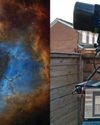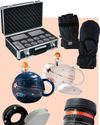
Creating a detailed astrophotography image typically involves these steps: imaging the target (known as taking 'light' frames); gathering a series of calibration images ('dark', 'flat' and 'bias' frames); using software to stack these images together to remove noise and increase the data signal; and, finally, stretching this data to boost our target's delicate details and making colour and gradient adjustments to perfect the image.
It's quite common to use multiple software programs to carry out the above steps - for example, stacking software followed by specialist processing software to do the rest. However, the free astrophotography processing software Siril is capable of supporting the entire workflow, from stacking data to managing background gradients and colour saturations afterwards. It comes pre-programmed with various scripts designed to automate many functions and even interfaces with other tools, including StarNet and Pixel Math, to perform additional processing steps.
We're going to run through how to stack data in Siril. Stacking is referred to as 'preprocessing' within Siril and occurs right at the start of the processing workflow.
هذه القصة مأخوذة من طبعة August 2024 من BBC Sky at Night Magazine.
ابدأ النسخة التجريبية المجانية من Magzter GOLD لمدة 7 أيام للوصول إلى آلاف القصص المتميزة المنسقة وأكثر من 9,000 مجلة وصحيفة.
بالفعل مشترك ? تسجيل الدخول
هذه القصة مأخوذة من طبعة August 2024 من BBC Sky at Night Magazine.
ابدأ النسخة التجريبية المجانية من Magzter GOLD لمدة 7 أيام للوصول إلى آلاف القصص المتميزة المنسقة وأكثر من 9,000 مجلة وصحيفة.
بالفعل مشترك? تسجيل الدخول

Putting cosmic rays to work
These penetrating interstellar particles have applications from astronomy to archaeology

Set up your first imaging sequence
How to automate and coordinate your gear over multiple nights of imaging

The Universe without gravity
Life with no gravity might sound a fun idea, but as Govert Schilling explains, shutting off this pivotalforce would spell disaster for Earth and beyond

How to blend images taken with different camera setups
Combine data captured at varied focal lengths to create rich, deep images

INSIDE THE SKY AT NIGHT
Back in September 2021, The Sky at Night show spoke to Carly Howett about NASA's then upcoming Lucy mission. As the spacecraft now approaches its main targets - the Trojan asteroids - we check in with her to see how the mission is going

The science of SCI-FI
We love a good sci-fi film, but do they get the science right? Amy Arthur picks six of the big mistakes made in space films

Seeing in a new light
It's National Astronomy Week this month, so take a tip from Mark Westmoquette and let mindful stargazing change your perspective on your life and problems

What to do if you find a meteorite
Ever come across an unusual rock and wondered if it's a meteorite? Mark McIntyre explains how to tell if that stone really is a fragment from outer space

GEAR
Charlotte Daniels rounds up the latest astronomical accessories

Q&A WITH A STELLAR ECLIPSE SPECIALIST
Many stars are gravitationally locked inside multi-star systems, but a rare new triple-star system has set a new record for how cosy these clusters can get